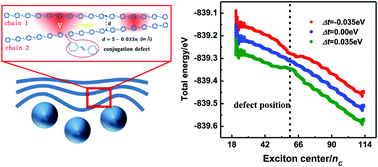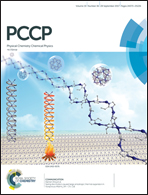Exciton transport in π-conjugated polymers with conjugation defects
Abstract
In π-conjugated polymers for photovoltaic applications, intrinsic conjugation defects are known to play crucial roles in impacting exciton transport after photoexcitation. However, the understanding of the associated microscopic processes still remains limited. Here, we present a theoretical investigation of the effects of different conjugation defects on the dynamics of exciton transport in two linearly coupled poly(p-phenylene vinylene) (PPV) molecules. The model system is constructed by employing an extended version of the Su–Schrieffer–Heeger model and the exciton behaviors are simulated by means of a quantum nonadiabatic dynamics. We identify two types of conjugation defects, i.e., weakening conjugation and strengthening conjugation, which are demonstrated to play different roles in impacting the dynamics of exciton transport in the system. The weakening conjugation acts as an energy well inclined to trap a moving exciton, while the strengthening conjugation acts as an energy barrier inclined to block the exciton. We also systematically simulate both intrachain and interchain dynamics of exciton transport, and find that an exciton could experience a “short-time delaying”, “trapping”, “blocking”, or “hopping” process, which is determined by the defect type, strength, and position. These findings provide a microscopic understanding of how the exciton transport dynamics can be impacted by conjugation defects in an actual polymer system.



 Please wait while we load your content...
Please wait while we load your content...